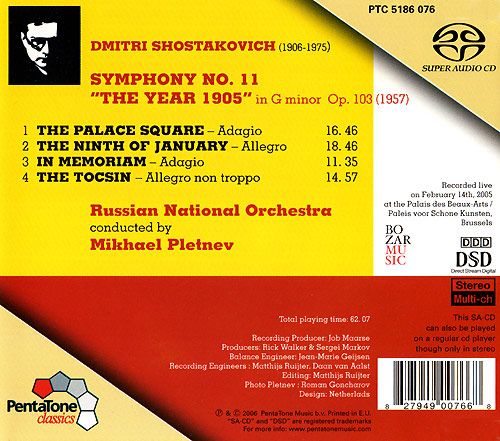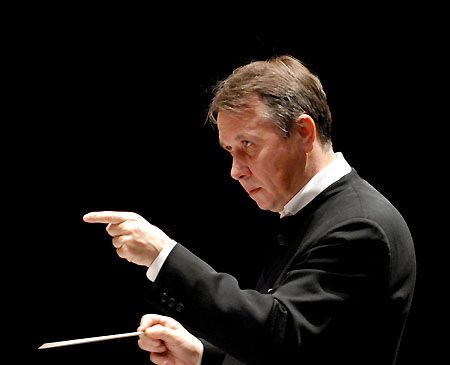wimpel69
12-10-2014, 11:26 AM
Another superb version of Shostakovich's "cinematic" Symphony No.11.
EAC-FLAC link below. This is my own rip.
Artwork & booklet included. Do not share. Buy the original!
Please leave a "Like" or "Thank you" if you enjoyed this!
Dmitri Shostakovich's Symphony No.11 ostensibly was written to commemorate the tragic events of
January 9, 1905, when several hundred of about 10,000 demonstrators at the Tsar's St. Petersburg winter
palace were killed on orders from government officials. The slaughter incited further demonstrations and
anti-Tsarist activities, culminating in the 1917 Bolshevik Revolution. Shostakovich would later claim, in the
controversial Volkov book Testimony, that the symphony's inspiration was actually the Hungarian Revolution
of 1956. In any event, the symphony was subtitled "1905," not "1956," and most of its themes were derived
from Russian revolutionary songs. Its four movements, all with subtitles, are played without pause. The first
(Adagio) is subtitled "The Palace Square" and opens in a somber, dark mood built on several motifs, a
crucial one on drums representing the protesters forming at the palace. Themes from two rather mournful
revolutionary songs, Listen and The Prisoner, are then presented and later developed. The movement is
permeated by ominous thudding drums, eerie string writing, and a growing sense of unrest. The nearly
20-minute second movement (Allegro - Adagio) is subtitled "The Ninth of January" and depicts the bloody
events of that day. It is the most complex and dramatic panel, recalling motivic and thematic material
from the first movement and using themes from two songs in Shostakovich's 10 Poems for chorus
without orchestra -- "Comrades, the Bugles Are Sounding" and "Bare Your Heads" -- the latter
reappearing at climactic moments in the third and fourth movements. The most dramatic music in the
second movement comes with the fugato section, which builds to a brutal, percussive climax using a
variant of the demonstrators' motif to depict the slaughter. The eerie quiet from the symphony's
opening follows, leading into the Adagio third movement. Subtitled "In Memoriam," it is mournful,
using the melody from the popular song "You Fell As a Victim." Later, the theme from another song,
"Welcome, the Free Word of Liberty," is quoted, after which comes a powerful climax. The finale
(Allegro non troppo) is subtitled "The Tocsin" (alarm bell). In its feverish opening, it alludes to the
music in Shostakovich's Symphony No.10's second movement, which supposedly satirizes
Stalin (Volkov). Later, the melody from "Rage, You Tyrants" is used and the movement gradually
takes on a defiant, triumphal air, with a bell tolling its warning at the symphony's powerful close.

Music Composed by
Dmitri Shostakovich
Played by the
Russian National Orchestra
Conducted by
Mikhail Pletnev

"Mikhail Pletnev’s Shostakovich Symphony No. 11 excels beyond the much-hyped
Rostropovich version on LSO Live, which suffers from a deadening slow, heavy
tread. Pletnev’s urgent pacing brings the piece in at around 62 minutes (10 minutes
less than Rostropovich), while his lively phrasing, attention to rhythm, and
powerful dynamic contrast makes for compelling listening. Even the long, slow
first movement–fatal in the wrong hands–remains interesting due to Pletnev’s
insistent rhythmic pulse and skillfully maintained tension. This tension gets
released in the swirling winds and strings of the second movement, and even
more so in the gripping march at the movement’s conclusion.
The Russian National Orchestra takes on these passages with discernible
enthusiasm, if not always razor-sharp articulation. In the slow movement,
Pletnev’s refusal to belabor the music has Shostakovich’s touching theme emerge
as a poignant elegy. In the finale, Pletnev drops the main theme’s tempo by
half–then launches full-speed into the following allegro, creating a bracing
dramatic effect. The percussion section is the star of this movement (and in
much else of the symphony), with bells and gongs ringing full-out from
the orchestra."
Classics Today

Download Link (re-up, music only) - http://depositfiles.com/files/vgaha3zzr
Source: Pentatone Classics, 2006 (my rip!)
Format: FLAC(RAR), DDD Stereo, Level: -5
File Size: 232 MB
Enjoy! Don't share! Buy the original! Please leave a "Like" or "Thank you" if you enjoyed this! :)
EAC-FLAC link below. This is my own rip.
Artwork & booklet included. Do not share. Buy the original!
Please leave a "Like" or "Thank you" if you enjoyed this!
Dmitri Shostakovich's Symphony No.11 ostensibly was written to commemorate the tragic events of
January 9, 1905, when several hundred of about 10,000 demonstrators at the Tsar's St. Petersburg winter
palace were killed on orders from government officials. The slaughter incited further demonstrations and
anti-Tsarist activities, culminating in the 1917 Bolshevik Revolution. Shostakovich would later claim, in the
controversial Volkov book Testimony, that the symphony's inspiration was actually the Hungarian Revolution
of 1956. In any event, the symphony was subtitled "1905," not "1956," and most of its themes were derived
from Russian revolutionary songs. Its four movements, all with subtitles, are played without pause. The first
(Adagio) is subtitled "The Palace Square" and opens in a somber, dark mood built on several motifs, a
crucial one on drums representing the protesters forming at the palace. Themes from two rather mournful
revolutionary songs, Listen and The Prisoner, are then presented and later developed. The movement is
permeated by ominous thudding drums, eerie string writing, and a growing sense of unrest. The nearly
20-minute second movement (Allegro - Adagio) is subtitled "The Ninth of January" and depicts the bloody
events of that day. It is the most complex and dramatic panel, recalling motivic and thematic material
from the first movement and using themes from two songs in Shostakovich's 10 Poems for chorus
without orchestra -- "Comrades, the Bugles Are Sounding" and "Bare Your Heads" -- the latter
reappearing at climactic moments in the third and fourth movements. The most dramatic music in the
second movement comes with the fugato section, which builds to a brutal, percussive climax using a
variant of the demonstrators' motif to depict the slaughter. The eerie quiet from the symphony's
opening follows, leading into the Adagio third movement. Subtitled "In Memoriam," it is mournful,
using the melody from the popular song "You Fell As a Victim." Later, the theme from another song,
"Welcome, the Free Word of Liberty," is quoted, after which comes a powerful climax. The finale
(Allegro non troppo) is subtitled "The Tocsin" (alarm bell). In its feverish opening, it alludes to the
music in Shostakovich's Symphony No.10's second movement, which supposedly satirizes
Stalin (Volkov). Later, the melody from "Rage, You Tyrants" is used and the movement gradually
takes on a defiant, triumphal air, with a bell tolling its warning at the symphony's powerful close.

Music Composed by
Dmitri Shostakovich
Played by the
Russian National Orchestra
Conducted by
Mikhail Pletnev

"Mikhail Pletnev’s Shostakovich Symphony No. 11 excels beyond the much-hyped
Rostropovich version on LSO Live, which suffers from a deadening slow, heavy
tread. Pletnev’s urgent pacing brings the piece in at around 62 minutes (10 minutes
less than Rostropovich), while his lively phrasing, attention to rhythm, and
powerful dynamic contrast makes for compelling listening. Even the long, slow
first movement–fatal in the wrong hands–remains interesting due to Pletnev’s
insistent rhythmic pulse and skillfully maintained tension. This tension gets
released in the swirling winds and strings of the second movement, and even
more so in the gripping march at the movement’s conclusion.
The Russian National Orchestra takes on these passages with discernible
enthusiasm, if not always razor-sharp articulation. In the slow movement,
Pletnev’s refusal to belabor the music has Shostakovich’s touching theme emerge
as a poignant elegy. In the finale, Pletnev drops the main theme’s tempo by
half–then launches full-speed into the following allegro, creating a bracing
dramatic effect. The percussion section is the star of this movement (and in
much else of the symphony), with bells and gongs ringing full-out from
the orchestra."
Classics Today

Download Link (re-up, music only) - http://depositfiles.com/files/vgaha3zzr
Source: Pentatone Classics, 2006 (my rip!)
Format: FLAC(RAR), DDD Stereo, Level: -5
File Size: 232 MB
Enjoy! Don't share! Buy the original! Please leave a "Like" or "Thank you" if you enjoyed this! :)